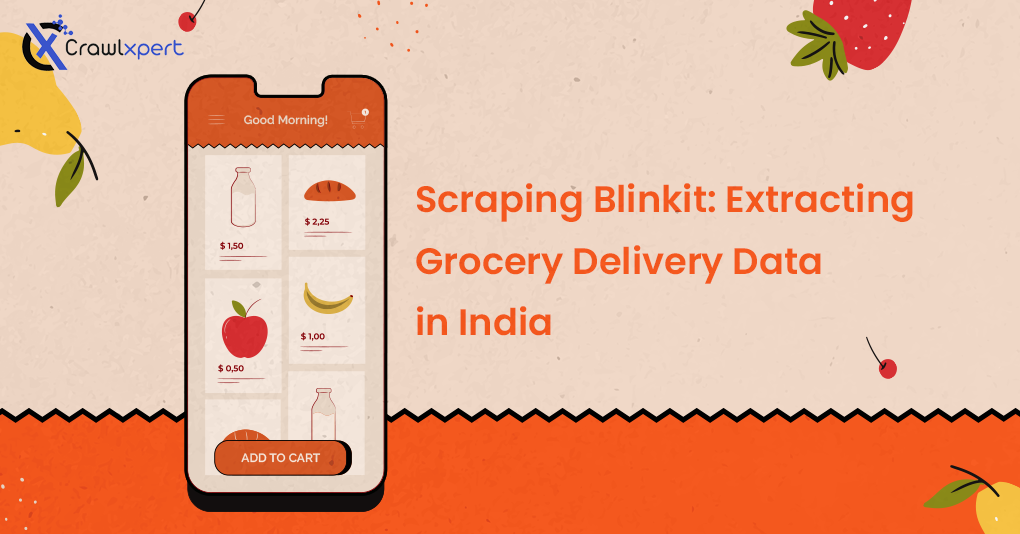
Scraping Blinkit: Extracting Grocery Delivery Data in India
2025 June 10
Introduction
In a digital economy, data-driven insights have become very important for any business that must stay competitive, especially in the rapidly growing online grocery delivery industry. Blinkit (born Grofers) ranks among India's top 10-minute grocery delivery platforms and offers a wide range of products, from fresh farm produce to grocery and household essentials.
Through web scraping of Blinkit's grocery delivery data in India, various other companies would be able to extract useful knowledge on pricing, availability of goods, delivery time, and customer behavior.
In this comprehensive guide, we will explain the whole process of web scraping Blinkit data, including the tools, techniques, challenges, solutions, and applications. All business owners, analysts, and developers will be able to use this guide to extract Blinkit data-related web scraping information for market research, competitor review, and price tracking purposes.
1. Why Scrape Blinkit Grocery Delivery Data in India?
(a) Competitive Pricing Analysis
- Track Pricing Trends: Extract real-time product pricing data to monitor how Blinkit adjusts its prices.
- Competitor Benchmarking: Compare Blinkit’s prices with other delivery services (e.g., Zepto, BigBasket, and Dunzo) to develop competitive pricing strategies.
- Dynamic Pricing Models: Use extracted pricing data to implement dynamic pricing strategies based on market fluctuations.
(b) Market Research and Consumer Insights
- Analyze Product Popularity: Track which products are frequently bought or promoted.
- Identify Demand Trends: Understand consumer preferences by analyzing high-demand items.
- Geographic Insights: Extract region-specific data to determine product popularity in different areas.
(c) Inventory and Stock Monitoring
- Track Stock Availability: Identify which products are frequently out of stock.
- Predict Supply Trends: Use data to anticipate future inventory shortages or surpluses.
- Competitor Stock Analysis: Compare Blinkit’s stock levels with competitors to evaluate supply chain efficiency.
(d) Marketing and Promotion Strategies
- Identify Discount Trends: Extract promotional pricing and discount data.
- Targeted Campaigns: Use data insights to launch targeted advertising and personalized offers.
- Optimize Ad Spend: Focus marketing efforts on trending or frequently discounted products.
2. Legal and Ethical Considerations
- Compliance with Blinkit’s Terms: Most websites have terms of service that prohibit or restrict automated data extraction. Review Blinkit’s terms before proceeding.
- Rate Limits and Respectful Scraping: To avoid overloading Blinkit’s servers, implement rate-limiting techniques and avoid aggressive scraping.
- Use Data for Ethical Purposes: Use the data only for market research, pricing analysis, and lawful business insights.
- Data Privacy: Avoid scraping sensitive or personally identifiable information (PII).
3. Tools and Technologies for Scraping Blinkit
(a) Python Libraries
- Requests: Sends HTTP/HTTPS requests to fetch webpage content.
- BeautifulSoup: Parses HTML and XML content for easy data extraction.
- Selenium: Automates browser interactions for dynamic content scraping.
- Pandas: Organizes and manipulates the scraped data into structured formats (CSV, JSON).
(b) Proxy Services
- ScraperAPI: Rotates IP addresses and handles CAPTCHAs automatically.
- Bright Data: Offers residential proxies to avoid detection.
- Smartproxy: Provides reliable and cost-effective proxy services.
(c) Browser Automation Tools
- Playwright: A modern web scraping tool for handling dynamic websites efficiently.
- Puppeteer: Automates headless Chrome browser for rendering JavaScript-heavy pages.
(d) Data Storage Options
- CSV/JSON: Suitable for small-scale data storage.
- MongoDB/MySQL: Ideal for larger datasets.
- Cloud Storage: Use AWS S3, Google Cloud Storage, or Azure Blob for scalability.
4. Setting Up Your Blinkit Scraper
(a) Install Required Libraries
First, install the necessary Python libraries by running the following commands:
pip install requests beautifulsoup4 selenium pandas(b) Inspect Blinkit’s Website Structure
- Open Blinkit’s website in Chrome.
- Right-click → Inspect → Elements.
- Identify HTML tags related to product listings, prices, and categories.
- Check how data loads (static HTML or dynamic JavaScript).
(c) Fetch the Blinkit Grocery Page
import requests
from bs4 import BeautifulSoup
url = 'https://www.blinkit.com/grocery'
headers = {'User-Agent': 'Mozilla/5.0'}
response = requests.get(url, headers=headers)
soup = BeautifulSoup(response.content, 'html.parser')(d) Extract Product Listings and Prices
products = soup.find_all('div', class_='ProductCard__container')
for product in products:
title = product.find('h3', class_='ProductCard__title').text
price = product.find('span', class_='ProductCard__price').text
print(f'Product: {title}, Price: {price}')5. Bypassing Anti-Scraping Mechanisms
(a) Use Proxies and IP Rotation
- Rotate IP addresses using a proxy service.
- Avoid getting blocked by continuously changing IPs.
proxies = {'http': 'http://user:pass@proxy-server:port'}
response = requests.get(url, headers=headers, proxies=proxies)(b) Add User-Agent Rotation
import random
user_agents = [
'Mozilla/5.0 (Windows NT 10.0; Win64; x64)',
'Mozilla/5.0 (Macintosh; Intel Mac OS X 10_15_7)'
]
headers = {'User-Agent': random.choice(user_agents)}(c) Use Selenium for Dynamic Content
from selenium import webdriver
from selenium.webdriver.chrome.options import Options
options = Options()
options.add_argument('--headless')
driver = webdriver.Chrome(options=options)
driver.get(url)
data = driver.page_source
driver.quit()
soup = BeautifulSoup(data, 'html.parser')6. Data Cleaning and Storage
import pandas as pd
data = {'Product': titles, 'Price': prices}
df = pd.DataFrame(data)
df.to_csv('blinkit_data.csv', index=False)7. Applications of Blinkit Data Scraping
(a) Real-Time Pricing Comparison
- Compare Blinkit’s pricing with competitors.
- Adjust your product pricing strategies dynamically.
(b) Market Trend Analysis
- Use Blinkit data to identify popular products and pricing trends.
- Gain insights into consumer buying behavior.
(c) Competitor Analysis
- Monitor Blinkit’s product categories, discounts, and availability.
- Benchmark against rival delivery platforms.
(d) Inventory and Stock Management
- Track product availability and predict stockouts.
- Improve supply chain management by monitoring inventory data.
Conclusion
The scraping of Blinkit grocery delivery data into India reveals vital facts on price trends, product availability, and market demand. You can simply extract and analyze Blinkit data for market research and competitive analysis using Python libraries, browser automation tools, and proxies for efficient use. But on the other hand, legality and ethical issues should be observed while doing web scraping.
With CrawlXpert's web scraping services, sample continuous and irregular data extraction and analysis are automated, robust, scalable, and well-matched for Blinkit database extraction. Take advantage of real-time grocery delivery data to make informed decisions for data-driven business activities and leave competitors behind.

